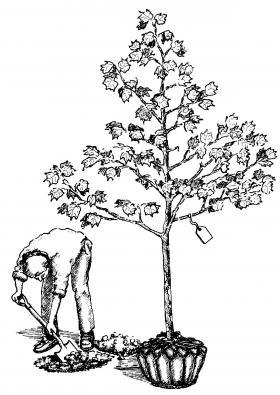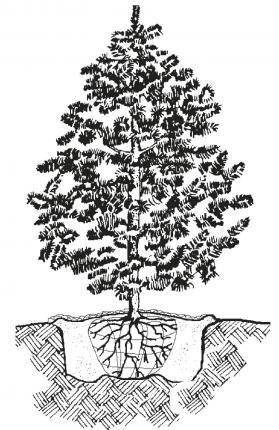Helpful hints on how to successfully plant your newly purchased trees, shrubs, and evergreens.
Planting trees, shrubs, or evergreens is a big investment in your garden. These plants make an impact on your yard and will last for years if properly planted and cared for. Here is a helpful guide on planting your new trees but as always our team is happy to answer any questions you have.
Your new trees should be installed as soon as possible. If there is some delay in planting, then it is important to guard against moisture loss. Store trees in a shady, wind-protected area, and keep the root area evenly moist.
Handle trees gently and use the container or rootball to move the plant. Be sure to place your plants in their preferred growing environment for best results.
 |
| Balled and burlap. |
 |
| This diagram illustrates the size of the planting hole that needs to be dug. |
|
|
|
|
|
|
Many trees, shrubs and evergreens have the root ball wrapped in burlap and secured with string or rope. Large sizes have the ball contained in a wire basket. These must be planted just the way they are, burlap, rope and wire basket too. Fill around the ball with a good soil mix to three-quarters of the way up the root ball, and water thoroughly.THEN – untie all string or rope from the trunk or stems. Fold back burlap and ropes and tuck down out of sight. If there is a wire basket, fold back the loops and push down, leaving the wire basket on. Add more good soil mix to fill the hole. Water again using a root-stimulating transplant fertilizer.
It is vital to dig your planting hole at least 5 in. larger than the root ball on all sides to allow for soil enrichment before planting. When planting large heavy balls, the soil at the bottom of the hole should be left untouched to prevent the tree from settling lower (see illustration). The finished level of the tree should be the same as it was grown or up to 3 in. (8 cm) higher.
We can not overstress the importance of leaving the pot ON! These pots are made of paper and will rot away in the soil, and are readily penetrated by healthy plant roots. Break off the pot rim down to the soil level. Make three cuts halfway up from the bottom. DO NOT remove the bottom of the pot. Fill in around the pot with a good soil mix. Water thoroughly with a root stimulating transplant fertilizer.
Water thoroughly before removing the container. If a light tapping on sides and bottom does not release the soil, make two cuts the length of the pot on opposite sides and gently pull away from the halves. Use your fingers or a knife to gently loosen and spread exposed roots that appear crowded. To free very matted or circling roots, make several vertical cuts 1/2- to 1-inch deep through the root mass. |
- Plant the tree or shrub no deeper than it grew at the nursery.
- It is necessary to plant trees and evergreens in a soil that offers good drainage. Therefore, if you are planting in an area with heavy clay soil, you must make certain modifications before planting.
- It is vital to dig your planting hole at least 5 in. larger than the root ball on all sides to allow for soil enrichment before planting.
|
- The high phosphorous transplanter-type fertilizer is the only appropriate fertilizer to be used in the first season.
- You can help to prevent permanent damage or discoloration caused by desiccation (drying out) of evergreens by watering thoroughly in the fall, before freeze-up.
- Divert downspouts and sprinklers away from the planting area.
- Water only when the soil feels dry to the touch, 2 to 3 in. down into the root area. Continue this form of watering until the plant is well established and growing.
- A good soil mix is 50 per cent soil, 25 per cent peat moss, 25 per cent compost or manure.